Genre: RPG Developer: AM2 Publisher: Sega Enterprises Players: 1 Released: 1990
“Genesis does what Nintendon’t. Introducing… The Sword of Vermilion.” A collective silence washed over my friends and me as the four of us sat gazing at that now classic ad in GamePro (hey, it was 1990). We had been gamers for a long time but had never seen anything like it. Vermilion looked incredible. All those pictures! First person adventuring with real-time combat! Fourteen towns and dungeons! 300 hours of gameplay! A 106-page hint book! And that dragon! They devoted an entire page just to him! Surely, if we were to buy only one game that year, this would have to be it. No game since Super Mario Bros. 3 had kept us this eager, and we could barely contain ourselves.
I was a big RPG fan in high school. Plenty of free time, nowhere to go really on weekends; it was the perfect environment for spending many an hour saving kingdom after kingdom. Having just come off Phantasy Star 2 , I of course had high hopes for Sword of Vermilion , very high hopes. If it played even remotely as good as it looked, it would be the end-all, be-all of RPGs.
Well, It looked good, but it played like a cardboard saxophone.
Cruel, cruel irony…
So much had been promised, so much hype had been built up around Vermilion that it was really impossible for the game to live up to it all. At the time, no one was really paying attention to the screenshots in that ad beyond the obvious eye candy effect that grabs you at first glance. They really do tell you all you need to know as to how simple and uninspired the game play actually is. I think Sega shot their wad with the graphics and music and had nothing left for the rest of the game.
As Erik the Fifth of Excalabria, you are on a mission to avenge your father’s death at the hand of the evil Tsarkon of Cartagena. Your father’s trusted servant Blade (no, not that Blade) raised you as his own and reveals your true heritage on his deathbed. He also gives you one of the eight magical rings needed to defeat Tsarkon.
Throughout your journey, you’ll travel from village to village in typical RPG fashion. This, however, is what practically kills the game. SoV falls into a deep linearity almost immediately and never recovers. The entire game can be summed up like this:
– Enter a town and talk to a villager who explains said town’s dilemma, tells you where to go to solve it, and gives you a map.
– Go to the cave (it’s always a cave) and beat the baddie or bring back the needed item.
– Get the map to the next area from the grateful villager, talk to the king, and get one of the eight rings. Wash, rinse, repeat.
Suddenly the fourteen towns hyped in the ad don’t sound quite so appealing. Granted, RPGs of this period were not famous for their complex and profound storylines, but there was at least some degree of exploration and discovery involved. Vermilion offers none of that. By the third town you are already hunting exclusively for the guy with the map so you can do what’s necessary to get the next ring. There are some high points, such as the town where everyone has been prematurely aged and the old couple who live in separate towns, but scenes of this type are few and aren’t used enough to give the game any real feeling. I like to play the hero and I want to feel like I’m genuinely needed and admired once I’ve saved the day. There’s no personality in SoV and it’s a shame. All you feel here is the urge to finish the game and shelve it. Moreover, the quest isn’t anywhere near as long as Sega suggested. 300 Hours of gameplay? Even without the 106-page hint book, there isn’t even 30. I guess Sega had Forrest Gump as a tester or something.
Incorporating the Official RPG Control Scheme (patent pending), Vermilion is easy to get into. All commands are brought up via a single window, and you can talk to others, search the immediate area, view and equip items, etc. Six kinds of magic can be equipped to use in battle and can be upgraded for a price. Only one magic type can be used at a time, so you’ll have to discover which is most effective in a given area. You travel through these areas in a first person perspective, which is pretty smooth once you remember that you’re playing a 5MEG Genesis cartridge.
Combat is handled in real time, which sounds much better than it really is. Consisting of moving your character around the screen, hacking wildly at anything that moves, there is little strategy save for knowing when to run away. Most monsters don’t even chase you, so you can get in a few whacks and then beat feet until they change direction again. This makes very little sense to me. Did Blinky back off when Pac-Man was in his sights? No! So why should 16-bit mutant apes prance about without a clue?
You can’t use any items while in combat so the only way to heal up is to scramble for the end of the screen and leave the battle (and much potential experience). While I liked the idea of switching to a real time engine for battle, so much more could have been done here. Combat is too simple and predictable. But that seems to be the norm here.
Even the enemies you face are boring. With only about 12 monster sprites in the whole game, palette-swapping is used to ensure you get some sort of a work out. Remember that Blue Jelly you whupped a while back? Well the Black Glop ain’t that easy!
Boss battles look spectacular but again, disappoint. Most don’t even move, and you’ll lose more HP by touching them than you will by their attacks. The engine shifts here as well, only this time combat is viewed from the side. Your character, who was a plump, little Gary-Oldman-in-Dracula-looking warrior, is now fully clad in plate mail from head to toe! All that armor has a price though, as he can’t jump. All he can do is lumber forward and back, using his one forward slash. He can duck but looks rather ridiculous doing so. Ever see an armored duck waddle? Since the bosses themselves offer little in the way of challenge, however, it’s all good.
Whatever budget Sword of Vermilion had must have gone into the graphics and music. The soundtrack in this game is amazing, and by itself is enough to warrant playing the game through to the end. The cave and village themes, for example, are varied and incredibly scored. Just about every song in the game is brilliant and would probably induce orgasmic spasms if ever remixed and released on CD (was that a bit much?). I cannot convey just how good the music is here. Luckily, you can hear the sound test by pressing A+B+C+start on controller two at the title screen. You can hear all the games excellent sounds, but the music is definitely something not to be missed.
Can you believe this title retailed for over $90 at release? Weighing in at only five megs, I can’t believe it was priced so high, especially since Wonder Boy in Monster World (also a five megger) is almost twice as long and cost almost half as much. Considering the sheer mediocrity of Vermilion I can’t help but chuckle when I think of my friend who bought it on release day (along with Strider. $72!).
Bottom line: Should you play it? Yes, if only to hear the music. Finding a complete copy with the guide may be tough (I got mine separate on ebay) but you shouldn’t have much trouble beating the game without it. While not a particularly bad game, it’s not a particularly good one either. It just goes to show that all flash and no substance does not a blockbuster make.
SCORE: 5 out of 10

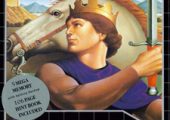
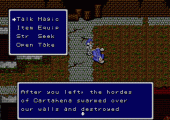
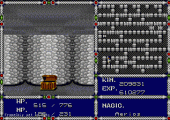
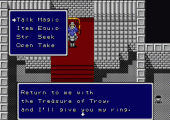
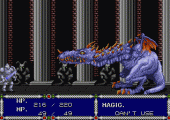
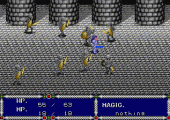
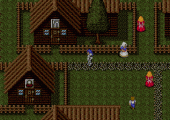
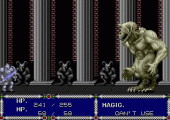
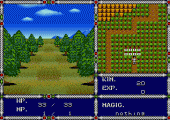
The review does a good job pointing out some of the flaws of this game. It is rather repetitive even for an early 16-bit rpg. All the towns basically look the same (either village template or town template), all the caves look exactly the same, and there is a whopping 9 different enemies you’ll be fighting over and over. So it’s pretty obvious the devs were a little lazy with this thing.
However, despite its many faults, Sword of Vermilion still manages to be fun. The active battle system is fantastic, and will really make you wish more rpgs did combat that way. The game’s backstory is actually quite interesting and grim, and as already mentioned the music really is fantastic. Furthermore the game’s menu system is easy to learn and well organized. It may seem like an odd thing to mention, but a lot of early rpgs really screwed this up, so it’s nice to see someone at Sega kept the gamers in mind when they programmed the pleasantly intuitive menus. Likewise the difficulty of this game is spot on. It’s not so difficult that you’ll have to spend countless hours level grinding, nor is it so easy that you can just walk through it.
Overall it’s a decent game, lacking in some areas, but still fun. I give it 6/10.
Definitely an OK game all things considered. The many game modes and great music make up for the blandness and repetivity.